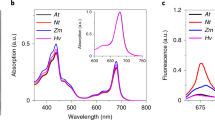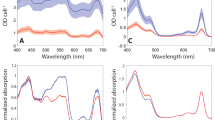Abstract
In order to maximize their use of light energy in photosynthesis, plants have molecules that act as light-harvesting antennae, which collect light quanta and deliver them to the reaction centres, where energy conversion into a chemical form takes place. The functioning of the antenna responds to the extreme changes in the intensity of sunlight encountered in nature1,2,3. In shade, light is efficiently harvested in photosynthesis. However, in full sunlight, much of the energy absorbed is not needed and there are vitally important switches to specific antenna states, which safely dissipate the excess energy as heat2,3. This is essential for plant survival4, because it provides protection against the potential photo-damage of the photosynthetic membrane5. But whereas the features that establish high photosynthetic efficiency have been highlighted6, almost nothing is known about the molecular nature of the dissipative states. Recently, the atomic structure of the major plant light-harvesting antenna protein, LHCII, has been determined by X-ray crystallography7. Here we demonstrate that this is the structure of a dissipative state of LHCII. We present a spectroscopic analysis of this crystal form, and identify the specific changes in configuration of its pigment population that give LHCII the intrinsic capability to regulate energy flow. This provides a molecular basis for understanding the control of photosynthetic light-harvesting.
This is a preview of subscription content, access via your institution
Access options
Subscribe to this journal
Receive 51 print issues and online access
$199.00 per year
only $3.90 per issue
Buy this article
- Purchase on Springer Link
- Instant access to full article PDF
Prices may be subject to local taxes which are calculated during checkout




Similar content being viewed by others
References
Demmig-Adams, B. & Adams, W. W. III. Antioxidants in photosynthesis and human nutrition. Science 298, 2149–2153 (2002)
Horton, P., Ruban, A. V. & Walters, R. G. Regulation of light harvesting in green plants. Annu. Rev. Plant Physiol. Plant Mol. Biol. 47, 655–684 (1996)
Niyogi, K. K. Photoprotection revisited. Annu. Rev. Plant Physiol. Plant Mol. Biol. 50, 333–359 (1999)
Külheim, C., Ågren, J. & Jansson, S. Rapid regulation of light harvesting and plant fitness in the field. Science 297, 91–93 (2002)
Barber, J. & Andersson, B. Too much of a good thing: light can be bad for photosynthesis. Trends Biochem. Sci. 17, 61–66 (1992)
van Amerongen, H. & van Grondelle, R. Understanding the energy transfer function of LHCII, the major light-harvesting complex of green plants. J. Phys. Chem. B 105, 604–617 (2001)
Liu, Z. et al. Crystal structure of spinach major light-harvesting complex at 2.72 Å resolution. Nature 428, 287–292 (2004 10.1038/nature02373)
Muller, P., Li, X. P. & Niyogi, K. K. Non-photochemical quenching. A response to excess light energy. Plant Physiol. 125, 1558–1566 (2001)
Horton, P. & Ruban, A. V. Molecular design of the photosystem II light harvesting antenna: photosynthesis and photoprotection. J. Exp. Bot. 56, 365–373 (2005)
Holt, N. E. et al. Carotenoid cation formation and the regulation of photosynthetic light harvesting. Science 307, 433–436 (2005)
Finazzi, G. et al. A zeaxanthin-independent nonphotochemical quenching mechanism localised in the photosystem II core complex. Proc. Natl Acad. Sci. USA 101, 12375–12380 (2004)
Standfuss, J. et al. Mechanisms of photoprotection and nonphotochemical quenching in pea light-harvesting complex at 2.5 Å resolution. EMBO J. 24, 919–928 (2005)
Moya, I. et al. Time-resolved fluorescence analysis of the photosystem II antenna proteins in detergent micelles and liposomes. Biochem 40, 12552–12561 (2001)
Mullet, J. E. & Arntzen, C. J. Simulation of grana stacking in a model membrane system. Biochim. Biophys. Acta 589, 100–117 (1980)
Mullineaux, C. W. et al. Excitation-energy quenching in aggregates of the LHCII chlorophyll-protein complex: a time-resolved fluorescence study. Biochim. Biophys. Acta 1141, 23–28 (1993)
Horton, P. et al. Control of the light harvesting function of chloroplast membranes by aggregation of the LHCII chlorophyll protein complex. FEBS Lett. 292, 1–4 (1991)
Ruban, A. V. & Horton, P. Mechanism of ΔpH-dependent dissipation of absorbed excitation energy by photosynthetic membranes. I. Spectroscopic analysis of isolated light harvesting complexes. Biochim. Biophys. Acta 1102, 30–38 (1992)
Ruban, A. V., Horton, P. & Robert, B. Resonance Raman spectroscopy of the photosystem II light harvesting complex of green plants. A comparison of the trimeric and aggregated states. Biochemistry 34, 2333–2337 (1995)
Robert, B., Horton, P., Pascal, A. A. & Ruban, A. V. Insights into the molecular dynamics of the plant light harvesting proteins in vivo. Trends Plant Sci. 9, 385–390 (2004)
Beddard, G. S. & Porter, G. Concentration quenching in chlorophyll. Nature 260, 366–367 (1976)
Remelli, R. et al. Chlorophyll binding to monomeric light-harvesting complex. J. Biol. Chem. 274, 33510–33521 (1999)
Wentworth, M., Ruban, A. V. & Horton, P. Thermodynamic investigation into the mechanism of the chlorophyll fluorescence quenching in isolated photosystem II light harvesting complexes. J. Biol. Chem. 278, 21845–21850 (2003)
Croce, R. et al. The neoxanthin binding site of the major light harvesting complex (LHCII) from higher plants. FEBS Lett. 456, 1–6 (1999)
Demmig-Adams, B. Carotenoids and photoprotection in plants: a role for the xanthophyll zeaxanthin. Biochim. Biophys. Acta 1020, 1–24 (1990)
Li, X. P. et al. A pigment-binding protein essential for regulation of photosynthetic light harvesting. Nature 403, 391–395 (2000)
Li, X. P. et al. Regulation of photosynthetic light harvesting involves intrathylakoid lumen pH sensing by the PsbS protein. J. Biol. Chem. 279, 22866–22874 (2004)
Ruban, A. V. et al. Determination of the stoichiometry and strength of binding of xanthophylls to the photosystem II light harvesting complexes. J. Biol. Chem. 274, 10458–10465 (1999)
Ruban, A. V., Pascal, A. A. & Robert, B. Xanthophylls of the major photosynthetic light-harvesting complex of plants: identification, conformation and dynamics. FEBS Lett. 477, 181–185 (2000)
Barzda, V. et al. Fluorescence lifetime heterogeneity in aggregates of LHCII revealed by time-resolved microscopy. Biophys. J. 81, 538–546 (2001)
Acknowledgements
This work was supported by UK Biotechnology and Biological Sciences Research Council, the INTRO2 European Union FP6 Marie Curie Research Training Network, The Royal Society, Nederlandse Organisatie voor Wetenschappelijk Onderzoek (NWO) through the research programme of the Stichting voor Fundamenteel Onderzoek der Materie (FOM), President Foundation of CAS, the Knowledge Innovation Project of CAS, and the National Natural Sciences Foundation of China. The authors thank J. W. Borst of the MicroSpectroscopy Centre at Wageningen University for help in enabling and performing the FLIM measurements and for discussions.
Author information
Authors and Affiliations
Corresponding authors
Ethics declarations
Competing interests
Reprints and permissions information is available at npg.nature.com/reprintsandpermissions. The authors declare no competing financial interests.
Rights and permissions
About this article
Cite this article
Pascal, A., Liu, Z., Broess, K. et al. Molecular basis of photoprotection and control of photosynthetic light-harvesting. Nature 436, 134–137 (2005). https://doi.org/10.1038/nature03795
Received:
Accepted:
Issue Date:
DOI: https://doi.org/10.1038/nature03795
This article is cited by
-
The nature of carotenoid S* state and its role in the nonphotochemical quenching of plants
Nature Communications (2024)
-
Excitation transfer and quenching in photosystem II, enlightened by carotenoid triplet state in leaves
Photosynthesis Research (2024)
-
Sustainable production of lutein—an underexplored commercially relevant pigment from microalgae
Biomass Conversion and Biorefinery (2024)
-
Cryo-EM structures of LHCII in photo-active and photo-protecting states reveal allosteric regulation of light harvesting and excess energy dissipation
Nature Plants (2023)
-
Towards the description of charge transfer states in solubilised LHCII using subsystem DFT
Photosynthesis Research (2023)
Comments
By submitting a comment you agree to abide by our Terms and Community Guidelines. If you find something abusive or that does not comply with our terms or guidelines please flag it as inappropriate.



